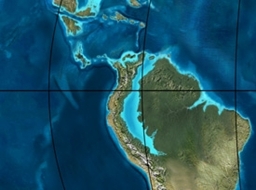Top Qs
Timeline
Chat
Perspective
Bogotá Formation
Geological formation in Bogotá, Colombia From Wikipedia, the free encyclopedia
Remove ads
The Bogotá Formation (Spanish: Formación Bogotá, E1-2b, Tpb, Pgb) is a geological formation of the Eastern Hills and Bogotá savanna on the Altiplano Cundiboyacense, Eastern Ranges of the Colombian Andes. The predominantly shale and siltstone formation, with sandstone beds intercalated, dates to the Paleogene period; Upper Paleocene to Lower Eocene epochs, with an age range of 61.66 to 52.5 Ma, spanning the Paleocene–Eocene Thermal Maximum. The thickness of the Bogotá Formation ranges from 169 metres (554 ft) near Tunja to 1,415 metres (4,642 ft) near Bogotá. Fossils of the ungulate Etayoa bacatensis have been found in the Bogotá Formation, as well as numerous reptiles, unnamed as of 2017.
Remove ads
Etymology
The formation was first described by Hettner in 1892,[1] then by Hubach in 1931, 1945 and 1957, and named in 1963 by Julivert after the Colombian capital Bogotá and its savanna.[2]
Description
Summarize
Perspective

Lithologies
The Bogotá Formation consists mainly of grayish-red, locally purplish, commonly greenish-gray, generally poorly stratified mudstone and silty claystone. Lithic arenite sandstone lenses, ranging from fine- to medium-grained, generally friable and variegated, are local constituents. Carbonaceous material is present as thin beds of low-grade argillaceous coal, north of Bogotá.[3][4] Fossil remains of Etaoya bacatensis, named after Colombian geologist Fernando Etayo and the indigenous name for the Bogotá savanna, Bacatá,[5] have been found in Ciudad Bolívar, close to the type locality of the Bogotá Formation.[6] Additionally, macroflora of Palaeophytocrene hammenii, named after Dutch botanist Thomas van der Hammen,[7] and pollen of Foveotriletes margaritae, Proxapertites operculatus and Foveotricolpites perforatus have been found, used for dating the formation.[1] Other pollen and flora, as Ulmoideipites krempii, Carpolithus, Anemocardium margaritae, and Hickeycarpum peltatum have been found in the Bogotá Formation.[8] The abundant paleosols of the Bogotá Formation show an increase in chemical weathering across the Paleocene-Eocene (P-E) transition; the Paleocene–Eocene Thermal Maximum.[9]
Later analysis has found several other species, such as pleurodire turtles, found at the Doña Juana dump,[10] dyrosaurid mesoeucrocodylians, boid snakes, dipnoan fishes, frogs, lizards, sebecid crocodyliforms and 11 fossils of mammals.[11] The find of a derived snake in the Lower Eocene section of the formation represents the oldest New World record.[12] The finds of iguanians, including the fossil record of hoplocercines, and boine, caenophidian, and ungaliophiine snakes, indicate a tropical forest environment, present just before the Early Eocene Climatic Optimum (EECO).[13] The faunal distribution has been correlated to the Carodnia-, Amphidolops-, and Wainka-bearing Peñas Coloradas Formation of the Golfo San Jorge Basin in Patagonia, Argentina.[14]
Stratigraphy and depositional environment
The Bogotá Formation, with a thickness of 169 metres (554 ft) close to Tunja to 1,415 metres (4,642 ft) near Bogotá,[15][16] overlies the Cacho Formation and is overlain by the Regadera Formation. The age has been estimated to be Late Paleocene to Early Eocene.[17] The middle part of the succession has been dated using detrital zircons at 56.2 ± 1.6 Ma.[3][18] The spread of ages based on zircons has been reported from 60.96 ± 0.7 to 53.6 ± 1.1 Ma.[19] The Bogotá Formation is laterally equivalent with the shales of the Socha Formation, the San Fernando Formation, the El Limbo Formation,[17] Los Cuervos Formation,[20] and the fossil-rich Cerrejón Formation of La Guajira.[11]
Remove ads
Outcrops
The Bogotá Formation is apart from its type locality, found in the synclinals of the Río Frío, Checua-Lenguazaque, Sesquilé, Sisga, Subachoque,[21] around Lake Suesca, in the Tenza Valley, and in the synclinals of Teusacá and Usme.[2][22][23] In the Usme Synclinal, the formation has a thickness of 436.5 metres (1,432 ft).[24] The campus of the Universidad La Javeriana has the Bogotá Formation as solid basement rock.[25]
The Bogotá Formation forms the footwall of the eastward compressional Chicamocha Fault,[21] and the footwall of the westward thrusting Bogotá Fault.[22]
Regional correlations
- Legend
- group
- important formation
- fossiliferous formation
- minor formation
- (age in Ma)
- proximal Llanos (Medina)[note 1]
- distal Llanos (Saltarin 1A well)[note 2]
Remove ads
Itaboraian correlations
Remove ads
See also
Notes and references
External links
Wikiwand - on
Seamless Wikipedia browsing. On steroids.
Remove ads




























